MAGA anti-Indian racism and antisemitism create a massive rift among conservatives
South Asians have played a prominent role in President Trump’s universe, especially in his second term.
Second Lady Usha Vance is the daughter of Indian immigrants who came to California to study and never went back. Harmeet Dhillon, born in India and a devout Sikh, is currently his U.S. assistant attorney general for the Civil Rights Division. And the head of the FBI, Kash Patel, is (like potential New York City Mayor Zohran Mamdani,) of Indian descent by way of Uganda.
Some Republicans have taken pride in this kind of diversity, citing it for the gains Trump made in 2024 with Black and Latino voters.
But these days, the MAGA big tent seems to be collapsing fast.
Last week, MAGA had a total anti-Indian meltdown on social media, revealing a deep, ugly racism toward South Asians.
It comes amid the first real rebellion about rampant and increasingly open antisemitism within the MAGAverse, creating a massive rift between traditional conservatives and a younger, rabidly anti-Jewish contingent called groypers whose leader, Nick Fuentes, recently posted that he is “team Hitler.”
Turns out, when you cultivate a political movement based on hate, at some point the hate is uncontrollable. In fact, that hate needs to be fed to maintain power — even if it means feasting on its own.
This monster of white-might ugliness is going to dominate policy and politics for the next election, and these now-public fights within the Republican party represent a new dynamic that will either force it to do some sort of soul searching, or purge it of anything but white Christian nationalism. My bet is on the latter. But if conservatives ever truly believed in their inclusive talk, then it’s time for Republicans to stand up and demand the big Trump tent they were hailing just a few months ago.
Ultra-conservative commentator Ben Shapiro, who opposes much of Fuentes’ worldview, summed up this Republican split succinctly.
Fuentes’ followers “are white supremacists, hate women, Jews, Hindus, many types of Christians, brown people of a wide variety of backgrounds, Blacks, America’s foreign policy and America’s constitution,” Shapiro explained. “They admire Hitler and Stalin and that splinter faction is now being facilitated and normalized within the mainstream Republican Party.”
MAGA’s anti-Indian sentiment had an explosive moment a few days ago when a South Asian woman asked Vice President JD Vance a series of questions during a Turning Point USA event in Mississippi. The young immigrant wanted to know how Vance could preach for the removal of nearly 18 million immigrants? And how could he claim that the United States was a Christian nation, rather than one that valued pluralism?
“How can you stop us and tell us we don’t belong here anymore?” the woman asked. “Why do I have to be a Christian?”
Vance’s answer went viral, in part because he claimed his wife, although from a Hindu family, was “agnostic or atheist,” and that he hoped she would convert to Christianity.
“Do I hope eventually that she is somehow moved by the same thing that I was moved in by church? Yeah, I honestly do wish that,” he said.
Vance later tried to do some damage control on social media, calling Usha Vance a “blessing” and promising to continue to “support her and talk to her about faith and life and everything else, because she’s my wife.”
But many South Asians felt Vance was dissing his wife’s heritage and attempting to downplay her non-whiteness. They vented on social media, and got a lot of MAGA feelings back.
“How can you pretend to be a white nativist politician who will ‘bring america back to it’s golden age’ … when your wife is an indian immigrant?” wrote one poster.
Dhillon received similar feedback recently for urging calm and fairness after a Sikh truck driver allegedly caused a fatal crash.
“[N]o ma’am, it is CRYSTAL CLEAR that sihks and hindus need to get the hell out of my country,” one reply stated. “You and your kind are no longer welcome here. Go the [expletive] home.”
Patel too, got it, after posting a message on Diwali, a religious holiday that celebrates the victory of light over darkness. He was dubbed a demon worshipper, a favorite anti-Indian trope.
Perhaps you’re thinking, “Duh, of course MAGA is racist.” But here’s the thing. The military has been scrubbed of many Black officers. The federal workforce, long a bastion for middle-class people of color, has been decimated. Minority cabinet members or top officials are few. Aside from another South Asian, Tulsi Gabbard, there’s Secretary of State Marco Rubio, Labor Secretary Lori Chavez‑DeRemer and HUD head Scott Turner.
South Asians are largely the last visible sign of pluralism in Republican power, an erstwhile proof that the charges of racism from the left are unfair. But now, like Latinos, they are increasingly targets of the base.
At the same time anti-Indian hate was surfacing last week, a whole load of MAGA antisemitism hit the fan. It started when Tucker Carlson, who in his post-network life has re-created himself as a hugely popular podcaster with more than 16 million followers on X, invited Fuentes on his show.
In addition to calling for the death of American Jews, Fuentes has also said women want him to rape them and should be burned alive, Black people belong in prison and LGBTQ+ people are an abomination.
Anyone who is not his kind of Christian “must be absolutely annihilated when we take power,” he said.
Turns out far-right Charlie Kirk was a bulwark against this straight-up American Nazi. Kirk’s popularity kept Fuentes — who often trolled Kirk — from achieving dominance as the spirit guide of young MAGA. Now, with Kirk slain, nothing appears to be stopping Fuentes from taking up that mantle.
After the Fuentes interview, sane conservatives (there are some left) were apoplectic that Carlson would support someone who so openly admits to being anti-Israel and seemingly pro-Nazi. They demanded the Heritage Foundation, historical backbone of the conservative movement, creators of Project 2025 and close allies of Tucker, do something. The head of Heritage, Kevin Roberts, offered what many considered a sorry-not-sorry. He condemned Fuentes, saying he was “fomenting Jew hatred, and his incitements are not only immoral and un-Christian, they risk violence.”
But also counseled that Fuentes shouldn’t be banished from the party.
“Join us — not to cancel — but to guide, challenge, and strengthen the conversation,” Roberts said.
Are Nazis really all bad? Discuss!
The response from ethical conservatives — Jewish and non-Jewish alike — has been that you don’t politely hear Nazis out, and if the Republican Party can’t clearly say that Nazis aren’t welcome, it’s got a problem.
Yes, the Republican Party has a problem.
The right rode to power by attacking what it denigrates at “wokeism” on the left. MAGA declared that to confront fascism or racism or misogyny — to tell its purveyors to sit down and shut up — was wrong. That “canceling,” or banishment from common discourse for spewing hate, was somehow an infringement on 1st Amendment rights or even terrorism.
They screamed loud and clear that speaking out against intolerance was the worst, most unacceptable form of intolerance itself — and would not be tolerated.
You know who heard them loud and clear? Fuentes. He has checkmated establishment Republicans with their own cowardice and hypocrisy.
So now his young Christian white supremacists are empowered, and intent on taking over as the leaders of the party. Fuentes is saying what old guard Republicans don’t want to hear, but secretly fear: He already is dangerously close to being the mainstream; just read the comments.
Roberts, the Heritage president, said it himself: “Diversity will never be our strength. Unity is our strength, and a lack of unity is a sign of weakness.”
Trying to shut Fuentes up or kick him out will likely anger that vocal and powerful part of the base that enjoys the freedom to be openly hateful, and really wouldn’t mind a male-dominated white Christian autocracy.
The far right has free-speeched their way into fascism, and Fuentes is loving every minute of it.
So now this remaining vestige of traditional conservatives — including senators such as Ted Cruz and Mitch McConnell — is faced with a painful reckoning. Many mainstream Republicans for years ignored the racism and antisemitism creeping into the party. They can’t anymore. It has grown into a beast ready to consume its maker.
Will they let this takeover happen, call for conversation over condemnation to the glee of Fuentes and his followers?
Or will they find the courage to be not just true Republicans, but true Americans, and declare non-negotiable for their party that most basic of American ideals: We do not tolerate hate?





